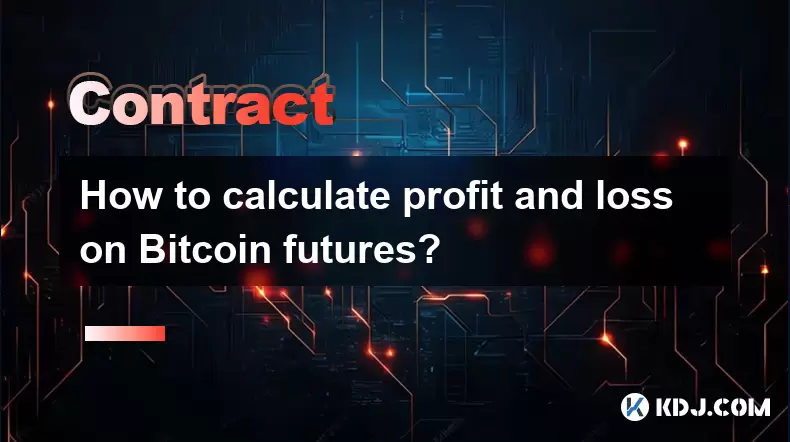-
 bitcoin
bitcoin $112195.049338 USD
2.42% -
 ethereum
ethereum $4124.915858 USD
2.81% -
 tether
tether $1.000570 USD
0.02% -
 xrp
xrp $2.861568 USD
2.25% -
 bnb
bnb $1000.346670 USD
3.04% -
 solana
solana $209.070819 USD
3.38% -
 usd-coin
usd-coin $0.999870 USD
0.02% -
 dogecoin
dogecoin $0.235379 USD
2.65% -
 tron
tron $0.335681 USD
-0.20% -
 cardano
cardano $0.803501 USD
3.38% -
 hyperliquid
hyperliquid $47.120881 USD
3.56% -
 chainlink
chainlink $21.501300 USD
3.44% -
 ethena-usde
ethena-usde $1.000571 USD
0.02% -
 avalanche
avalanche $29.793378 USD
3.62% -
 stellar
stellar $0.366964 USD
2.42%
How to calculate profit and loss on Bitcoin futures?
Bitcoin futures let traders bet on BTC's price without owning it, with profit/loss calculated using entry/exit prices, position size, and contract value.
Jul 14, 2025 at 09:49 pm

Understanding Bitcoin Futures and Their Nature
Bitcoin futures are derivative contracts that allow traders to speculate on the future price of Bitcoin without owning the underlying asset. These instruments are popular among both retail and institutional investors due to their leverage capabilities and potential for profit in both rising and falling markets. Understanding how these contracts work is essential before calculating profit and loss (PnL).
Each Bitcoin futures contract has a specific size, often denominated in USD or BTC. For example, some exchanges offer contracts worth $10 or $100 per tick. The value of the contract fluctuates based on the market price of Bitcoin. Traders can go long (betting the price will rise) or short (betting the price will fall). The difference between entry and exit prices, multiplied by the number of contracts and the contract size, determines the PnL.
Key Components in Calculating Profit and Loss
To calculate your profit or loss accurately, you must understand several critical components:
- Entry Price: This is the price at which you opened your position.
- Exit Price: This is the price at which you closed your position.
- Position Size: Refers to the number of contracts you traded.
- Contract Value: The dollar or BTC value per contract.
- Leverage Used: If trading with borrowed funds, leverage amplifies both gains and losses.
- Fees and Funding Rates: These reduce your net profit or increase your net loss.
The basic formula for calculating PnL is: (Exit Price – Entry Price) × Position Size × Contract Value. However, this changes slightly depending on whether you're using isolated or cross margin and whether the trade was leveraged.
Calculating PnL for Long Positions
When you open a long position on Bitcoin futures, you expect the price of Bitcoin to increase. Let’s assume you buy 5 contracts at an entry price of $30,000, with each contract valued at $10 per $1 move in price.
If Bitcoin rises to $32,000 and you decide to close your position:
- The price difference is $2,000.
- Multiply this by the number of contracts (5) and the contract value ($10).
- Your profit would be: $2,000 × 5 × $10 = $100,000.
However, if the price drops to $28,000 instead:
- The price difference is -$2,000.
- Multiply this by 5 contracts and $10 per contract.
- Your loss would be: -$2,000 × 5 × $10 = -$100,000.
Remember to subtract any fees and funding costs from your final result.
Calculating PnL for Short Positions
Shorting Bitcoin futures means you’re betting the price will fall. Using the same parameters as above, suppose you open a short position with 5 contracts at $30,000.
If the price drops to $28,000:
- The price difference is -$2,000 (but since it's a short, this becomes a gain).
- Multiply by 5 contracts and $10 per contract.
- Profit equals: -$2,000 × 5 × $10 = $100,000.
Conversely, if the price rises to $32,000:
- The price difference is +$2,000 (a loss for a short position).
- Multiply by 5 contracts and $10.
- Loss equals: $2,000 × 5 × $10 = -$100,000.
In both cases, ensure you account for transaction fees and funding payments, which may vary daily depending on the exchange and market conditions.
Impact of Leverage on Profit and Loss Calculation
Leverage allows traders to control larger positions with smaller capital. While it increases potential profits, it also magnifies losses. For example, opening a $100,000 position with 10x leverage requires only $10,000 in margin.
Let’s say you use 10x leverage on a $30,000 entry with 5 contracts:
- Your total exposure is still calculated the same way.
- However, a small adverse price movement can trigger a liquidation if your margin is insufficient.
For instance, a 5% drop in price could wipe out your entire margin if leverage is high and stop-loss levels are not set properly. Always consider liquidation price when factoring in risk.
Some platforms automatically deduct maintenance margin from your available balance, so it's crucial to track equity changes in real-time.
Frequently Asked Questions
Q1: How do I calculate PnL in BTC terms instead of USD?To calculate PnL in BTC, divide the USD profit or loss by the exit price. For example, if your profit is $10,000 and the exit price is $30,000, your profit in BTC is $10,000 / $30,000 ≈ 0.333 BTC.
Q2: What happens if I partially close my position?You can close part of your position while keeping the rest open. Each partial close is calculated separately using the same formula. Your remaining open position continues to fluctuate based on the current market price.
Q3: Are unrealized PnL calculations different from realized ones?Yes. Unrealized PnL refers to gains or losses on open positions, while realized PnL occurs when you close a position. Unrealized PnL is theoretical until the position is closed.
Q4: Do funding rates affect PnL even if I don’t close my position?Absolutely. Funding rates are periodic payments exchanged between long and short traders on perpetual futures. These are applied every 8 hours and can either add to or reduce your unrealized PnL.
Disclaimer:info@kdj.com
The information provided is not trading advice. kdj.com does not assume any responsibility for any investments made based on the information provided in this article. Cryptocurrencies are highly volatile and it is highly recommended that you invest with caution after thorough research!
If you believe that the content used on this website infringes your copyright, please contact us immediately (info@kdj.com) and we will delete it promptly.
- Navigating Misinformation: Ensuring Safety in the Pi Network Ecosystem
- 2025-09-29 14:25:13
- XRP Price Prediction: September 29th's Crypto Comeback?
- 2025-09-29 14:25:13
- Polkadot vs. Lyno AI: Decoding the Price Forecast and AI Revolution
- 2025-09-29 14:30:01
- Trump's Brahmastra: Can Stable Coin Save the US Economy?
- 2025-09-29 14:45:17
- Pi Movement: Utility, Community, and the $314,159 Dream
- 2025-09-29 14:45:17
- Ruvi AI: Revolutionizing the Creator Economy with AI-Powered Crypto
- 2025-09-29 14:30:01
Related knowledge

How do I use the scheduled order feature in Cardano (ADA) contracts?
Sep 28,2025 at 10:18pm
Understanding Scheduled Orders in Cardano Smart ContractsCardano operates on a proof-of-stakes consensus mechanism and uses the Plutus scripting langu...

How do I enable the "scalping-only" mode for Cardano (ADA) contracts?
Sep 24,2025 at 03:19am
Understanding Scalping Strategies in Crypto Derivatives1. Scalping in cryptocurrency trading refers to executing multiple short-term trades within min...

What is the settlement time for Cardano (ADA) contracts?
Sep 28,2025 at 04:18am
Understanding Cardano's Contract Settlement Mechanism1. Cardano operates on a proof-of-stake consensus model known as Ouroboros, which fundamentally i...

How do I add margin to Cardano (ADA) contracts?
Sep 27,2025 at 07:54pm
Understanding Margin in Cardano (ADA) Smart ContractsCardano operates on a proof-of-stake blockchain that supports smart contracts through its Plutus ...

What is the maximum position limit for Cardano (ADA) contracts?
Sep 23,2025 at 11:00pm
Understanding ADA Futures and Derivatives Market Structure1. Cardano (ADA) futures contracts are offered by several major cryptocurrency derivatives e...

What is the maker fee for Cardano (ADA) contracts?
Sep 26,2025 at 09:01am
Understanding Maker Fees in Cardano (ADA) Contracts1. The concept of maker fees applies broadly across decentralized exchanges and smart contract plat...

How do I use the scheduled order feature in Cardano (ADA) contracts?
Sep 28,2025 at 10:18pm
Understanding Scheduled Orders in Cardano Smart ContractsCardano operates on a proof-of-stakes consensus mechanism and uses the Plutus scripting langu...

How do I enable the "scalping-only" mode for Cardano (ADA) contracts?
Sep 24,2025 at 03:19am
Understanding Scalping Strategies in Crypto Derivatives1. Scalping in cryptocurrency trading refers to executing multiple short-term trades within min...

What is the settlement time for Cardano (ADA) contracts?
Sep 28,2025 at 04:18am
Understanding Cardano's Contract Settlement Mechanism1. Cardano operates on a proof-of-stake consensus model known as Ouroboros, which fundamentally i...

How do I add margin to Cardano (ADA) contracts?
Sep 27,2025 at 07:54pm
Understanding Margin in Cardano (ADA) Smart ContractsCardano operates on a proof-of-stake blockchain that supports smart contracts through its Plutus ...

What is the maximum position limit for Cardano (ADA) contracts?
Sep 23,2025 at 11:00pm
Understanding ADA Futures and Derivatives Market Structure1. Cardano (ADA) futures contracts are offered by several major cryptocurrency derivatives e...

What is the maker fee for Cardano (ADA) contracts?
Sep 26,2025 at 09:01am
Understanding Maker Fees in Cardano (ADA) Contracts1. The concept of maker fees applies broadly across decentralized exchanges and smart contract plat...
See all articles










































































